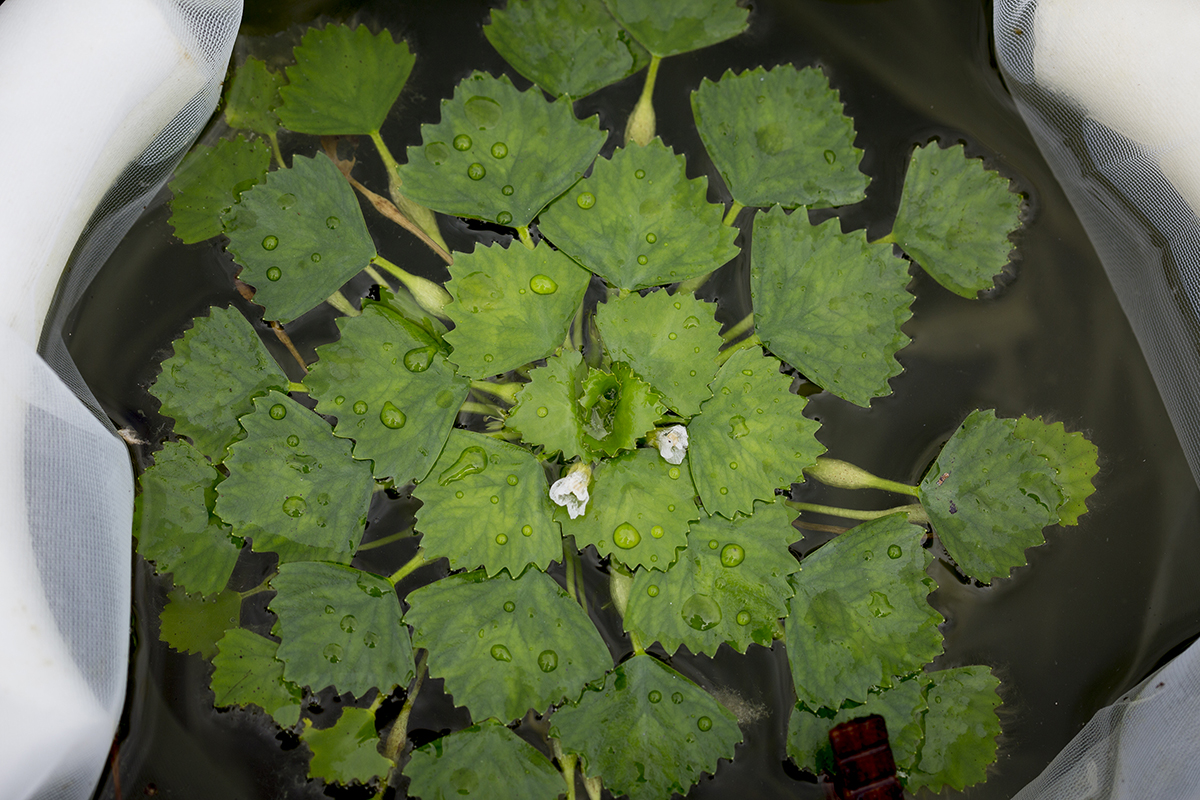Herbicides can't stop invasive plants. Can bugs?
By Krisy Gashler

Over the past 35 years, state and federal agencies have spent millions of dollars and dumped untold quantities of herbicides into waterways trying to control the invasive water chestnut plant, but the intruder just keeps spreading.
Bernd Blossey, associate professor of natural resources, has a better idea: Let bugs do the work.
Blossey is nearing the end of a research program that has identified a leaf beetle, Galerucella birmanica, that feasts on water chestnuts in its native China, as the perfect predator to help clear New York’s waters.
Water chestnut (Trapa natans) is native to Europe, Asia and Africa. It was introduced to North America through the Botanic Gardens in Cambridge, Massachusetts, in the 1870s. Since then, water chestnut has spread across the Northeast, into Canada and as far south as Virginia. With no natural predators, water chestnut overtakes its environment, forming floating mats of vegetation that make rivers and lakes impassable for boats and swimmers, and prevents light and oxygen from reaching plants and creatures below.
If the beetle proves to be an effective predator against water chestnut, the benefit could be felt in millions of dollars in savings for wildlife agencies and provide a more sustainable approach to using herbicide to knock back the invasive plant.
In a carefully controlled, quarantined environment, Blossey and his research team have found that G. birmanica is “very, very specific” in eating water chestnut plants and very little else. Blossey obtained the leaf beetles from the Wuhan Botanical Garden in Hubei province, China.
“We had to get permission from the Chinese authorities to bring them out and the U.S. authorities to bring them in,” Blossey said. “We’ve tried 50 different plant species, and the insects are as specific as we’d hoped they were. We’re really, really pleased with the progress we have made.”
Water chestnut is found throughout much of the Finger Lakes, central New York and tributaries to Lake Ontario. The species has invaded eastern coastal states and, Blossey warns, could be ready for a rapid westward expansion through the Great Lakes human and cargo transportation system.
Millions of dollars have been spent to thwart water chestnut’s spread. Each year $500,000 is spent on eradication efforts on Lake Champlain alone. This year, the Finger Lakes Partnership for Regional Invasive Species Management received a $750,000 grant from the Great Lakes Restoration Initiative for hand pulling of the invasive plant.
Blossey also studies invasiveness in plant species generally. Very few introduced plant species become problematic: Of all plant species moved outside their natural habitats, only 10 percent become established at all, and only 1 percent become invasive.

In 1995, Blossey and Rolf Nötzold, then of the international Institute of Biological Control, European Station, proposed a hypothesis to explain why some species become invasive while others don’t: the evolution of increased competitive ability hypothesis.
“Some of the species that are serious invaders outside the home range are hammered inside the home range by predators or diseases. If you have a lot of natural enemies, you develop a lot of defenses. So when they leave the home range, they have less competition and they thrive,” Blossey said.
This isn’t the first time Blossey has helped address an out-of-control invasive species through biological control. In 1992 he led a team that tested insects as biological controls for the invasive purple loosestrife, a European wetland plant that has spread throughout North America. The team gained federal and state approval to release four insects that attack the plant: two leaf beetles and two weevils, which jointly go after the plant’s roots, leaves and flowers.
Another project, on which Blossey has worked for 18 years with collaborators in Europe and Rhode Island, involves controlling common reed, Phragmites australis, another wetland plant invader. The team is investigating stem-eating moths, which are “almost 100 percent specific” to the invasive plant, he said.
As for the water chestnuts, there are still some questions to be answered and additional tests that Blossey plans to run early next spring. If all goes well, he would then submit a petition to a U.S. Department of Agriculture oversight group, asking for permission to release the insects.
“We hope to release them in 2018,” Blossey said. “That’s an incredibly quick timeline, but we’ve had a good work plan, and the insects were really, really cooperative.”
Blossey’s work on water chestnuts has been supported in part by the New York State Department of Environmental Conservation through the New York Invasive Species Research Institute at Cornell University.
Krisy Gashler is a freelance writer for the College of Agriculture and Life Sciences.
Media Contact
Get Cornell news delivered right to your inbox.
Subscribe